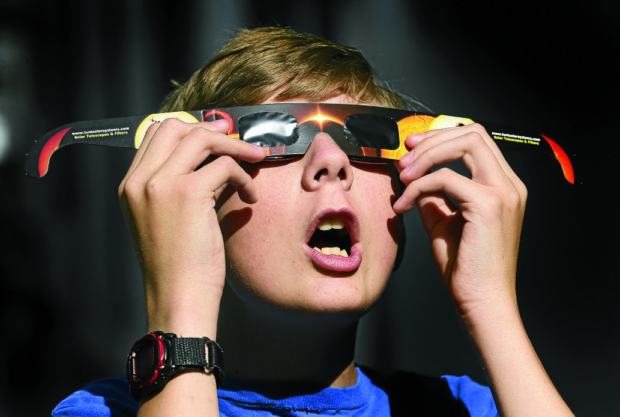Pinoys would have to make do with lunar eclipse

ECLIPSE WATCH Colton Hammer tries out his new eclipse glasses he bought from the Clark Planetarium in Salt Lake City in preparation for Monday’s solar eclipse visible in North America. —AP
Filipinos may have missed the first total solar eclipse that unfolded from coast to coast of the United States in nearly a century, but they will witness another celestial spectacle on Jan. 31 next year — a lunar eclipse called a full “blood moon.”
Lunar eclipses are usually characterized by the moon or a portion of it turning reddish, as the sun, Earth and full moon align or nearly align, earning the phenomenon the name blood moon.
The Philippines will be missing out on this year’s biggest astronomical event — a total solar eclipse — but skywatchers can tune in to live video streams and images of the event online, courtesy of the National Aeronautics and Space Administration (Nasa).
The program for the total solar eclipse on Aug. 21 will start at noontime Eastern daylight time (EDT), starting with a “preview show” hosted from Charleston, South Carolina, according to the Nasa website (www.nasa.gov).
Images taken by 11 spacecraft—including three Nasa aircraft, 50 high-altitude balloons and astronauts aboard the International Space Station—will also be uploaded to the website before, during and after the eclipse.
Article continues after this advertisementAll of North America will be able to view the eclipse, but viewers in other parts of the world, such as the Philippines, where the eclipse will not be visible, can monitor the Nasa website’s photo galleries and live video feeds.
Article continues after this advertisementThe video feeds may also be viewed on Nasa’s social media accounts including on Facebook, Twitter, Twitch TV, Ustream and YouTube.
The Philippine Atmospheric Geophysical and Astronomical Services Administration (Pagasa), in its astronomical diary for August, said the solar eclipse would happen starting 11:46 p.m. Philippine Standard Time on Aug. 21 (Monday).
The eclipse will be visible in Hawaii, the Americas except southern parts of South America, westernmost Europe and West Africa, Pagasa said.
After weeks of anticipation, the sight of the moon’s shadow passing directly in front of the sun, blotting out all but the halo-like solar corona, will draw one of the largest audiences in human history, experts say.
Smashing records
When those watching via social and broadcast media are included, the spectacle will likely smash records.
Some 12 million people live in the 113-kilometer-wide, 4,000-km-long zone in the United States where the total eclipse will appear on Monday. Millions of others have traveled to spots along the route to bask in its full glory.
Murphy, North Carolina, in the Smoky Mountains about two hours north of Atlanta, is among hundreds of small towns that are preparing for a huge influx of visitors.
“The weather forecast for Monday is beautiful, probably not a cloud in the sky all day,” said Dave Vanderlaan, 61, a retired landscaper.
“We’re busy, but tomorrow anybody in Atlanta who says they want to see total, they’re going to come up to this area, so it could be crazy,” Vanderlaan added.
The phenomenon will first appear at 10:15 a.m. Pacific daylight time (1715 GMT) near Depoe Bay, Oregon. Some 94 minutes later, at 2:49 p.m. EDT (1849 GMT), totality will take its final bow near Charleston, South Carolina.
1918 spectacle
The last time such a spectacle unfolded from the Pacific to the Atlantic coast was in 1918. The last total eclipse seen anywhere in the United States took place in 1979.
In Depoe Bay, a town of about 1,500 people, clear skies on Sunday raised hopes that the corona would be visible and not obscured by coastal haze or cloud.
Lisa Black, from Vancouver, Canada, said she and her party planned to have breakfast on the beach and be ready with their glasses.
“And, yeah, it will be cool to be able to look out at the ocean and just have the openness when it goes totally dark,” she said.
For millions of others who can’t get there, a partial eclipse of the sun will appear throughout North America if there is no local cloud cover.
Eclipse chaser
Perhaps never before have so many people had the opportunity to see a total eclipse, said Michael Zeiler, a self-described “eclipse chaser” who on Monday would notch his ninth time seeing “totality.”
Weeks of publicity have fanned excitement, he said, and might have persuaded many families to make last-minute plans for a road trip to the zone.
Zeiler, who runs GreatAmericanEclipse.com, a website devoted to the event, estimates that up to 7.4 million people will travel to the zone to observe the total eclipse, which takes place in the peak vacation month of August.
Many people have trekked to remote national forests and parks of Oregon, Idaho and Wyoming, while others have bought tickets to watch the show en masse in a Carbondale, Illinois, football stadium, a two-hour drive southeast of St. Louis.
In South Carolina, Charleston County’s more than 16,000 hotel rooms are booked, tourism officials say. Police expect up to 100,000 visitors to the area on Monday.
Those who live along the path, which cuts through a few population centers like Kansas City and Nashville, Tennessee, can simply walk out their homes and look skyward.
Avoid eye damage
For all but the couple of minutes of totality, observers must wear specially designed solar-safe sunglasses or filters to avoid severe eye damage. It is never safe to gaze directly at a partial eclipse with the naked eye.
Unlike many other astronomical events, such as comets and meteor showers, that often fail to live up to their hype, a total eclipse is nearly a sure thing, so long as the weather cooperates, experts say. —Reports from Jaymee T. Gamil and the wires